Basic steps to build a website in python
How to use python to build a website?
Related recommendations: "python Video"

1-Project environment setup.
1.1 Third-party library preparation
The development environment is mac os and ubantu. It is recommended that you download a third-party software called "Anaconda". The installation is very simple, just run the script directly.
After the installation is complete, you can run pip list on the command line. You can see the installed python third-party libraries.
At this time we do not have a django library.
pip install Django
Installation is complete in one sentence. What counts as success? You can directly import django in the python you write, and it will succeed without error. The database we chose is mysql, and django also needs to install middleware, which is similar to JDBC in java.
pip install MySQL-python
How to succeed? Just import _mysql in python. If there is no error, congratulations, the installation is basically completed.
1.2 IDE installation
IDE uses eclipse, talk about a tool Pydev, install Baidu by yourself, just click.
Then go to Eclipse New->Project->Pydev->Pydev Django Project, all the way to next. I found that eclipse could not find the Django environment. I came back and clicked here to configure an interpreter and then deleted the one named python in the python interpreter. It is the system default and changed it to python in bin/ under the anaconda directory. The default is 2.7.11. Forgot the installation directory? Type sudo find / -name anacon* .

2-Database configuration and use
2.1 Database connection file configuration
I chose mysql, of course You should have determined your mysql account and password before this. mysql configuration should be simple. But if you want to support remote access, for example, if you put the database on the cloud or on someone else's machine, after all, development is not a one-person thing. The pitfall I encountered was "about the bind-address" in the mysql configuration file. I went to Baidu. The solution is to just delete it. (I recommend several desktop software for mysql connection, Navicat or mysql workbench are both good). (Later I found that entering the password and account here was of no use and I had to modify the settings in the app with the same name as the project).Because the web page is mainly in MVC mode, let’s create two. One called db is dedicated to managing the database (models layer) and the second is dedicated to background logic. The name is chosen casually because it may correspond to multiple modules. To add an app in Django, you need to add the app name to Installed_app in the setting of the app with the same name as the project (Figure 4). We add the next directory structure. 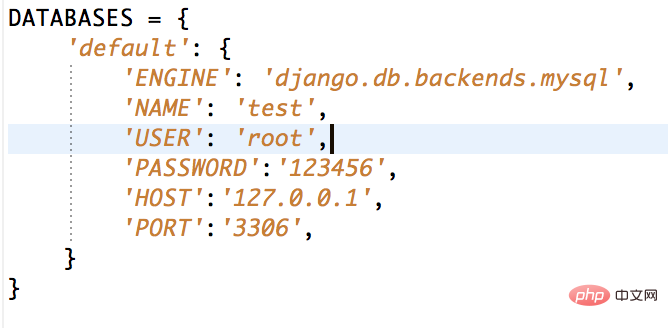 Good fields, because Django's goal is to completely separate programmers from database operations. So let’s not create the table first, cd to your project directory, and type the manage.py migrate command from the command line.
Good fields, because Django's goal is to completely separate programmers from database operations. So let’s not create the table first, cd to your project directory, and type the manage.py migrate command from the command line.
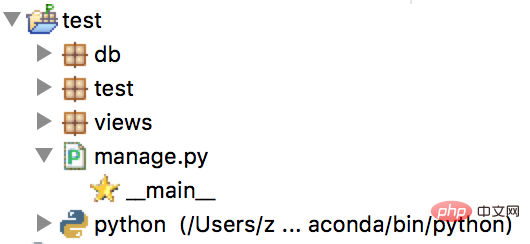 If your configuration is correct, django has already created many tables in your database at this time, all of which come with django, and I have not used them. , the only thing used is the database management interface that comes with Django, which is similar to Navicat and also supports search functions. Go to the documentation http://python.usyiyi.cn/django_182/intro/tutorial02.html to learn it yourself.
If your configuration is correct, django has already created many tables in your database at this time, all of which come with django, and I have not used them. , the only thing used is the database management interface that comes with Django, which is similar to Navicat and also supports search functions. Go to the documentation http://python.usyiyi.cn/django_182/intro/tutorial02.html to learn it yourself. 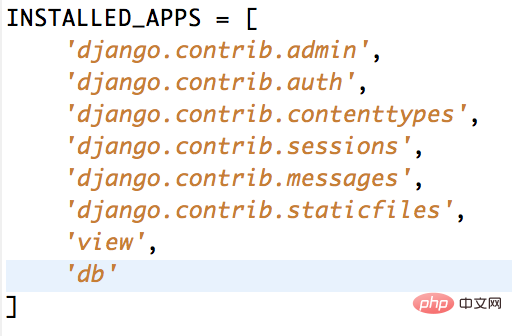
from __future__ import unicode_literals
from django.db import models
# Create your db here.
class Message(models.Model):
user_id = models.BigIntegerField(blank=True, null=True) [object Object]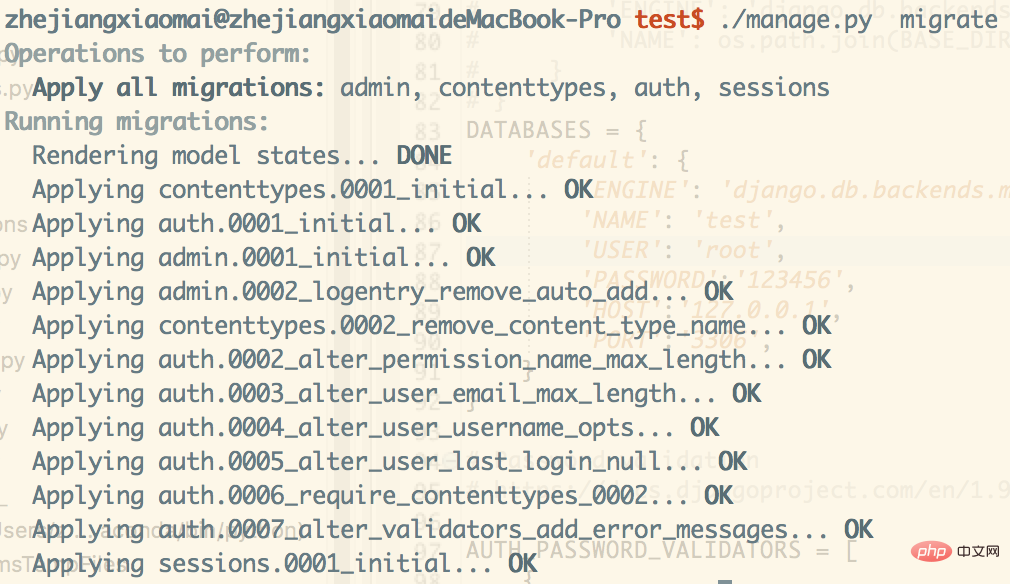 You will know after using it, it will generate the code of the table in reverse, and then copy it directly into the models.
You will know after using it, it will generate the code of the table in reverse, and then copy it directly into the models.
3.1url matching processing function
In Django, generally url parsing is divided into two layers.
The first layer is responsible for parsing the name of the APP, like what I wrote in urls.py in the test. The first parameter represents the response URL, and the second parameter represents the processing module. 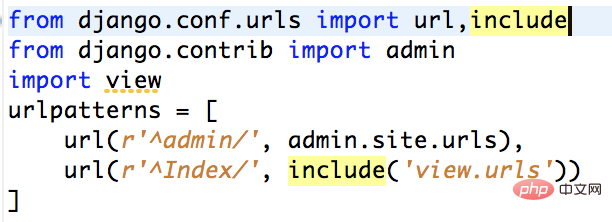
The second level is to parse to a function in a specific module to respond to the corresponding url.
For example, in the urls.py in the view app (you need to create it yourself), the home in the url written (the first parameter in the function is the matching path, and the latter is the corresponding function name) corresponds to the views in the view app. The function home in .py 
3.2 Static web page configuration
In fact, the response can be achieved by this time. (There is still a problem to solve here 'Index/home.html') Where is it? We now create a folder called templates. All html should be placed here. Index is the name of a module. You can create many folders under templates, corresponding to many APP modules. (HTML does not belong to the scope of this article) At this time, the directory structure is 
After you have done that, don’t forget to add a code in the test setting. 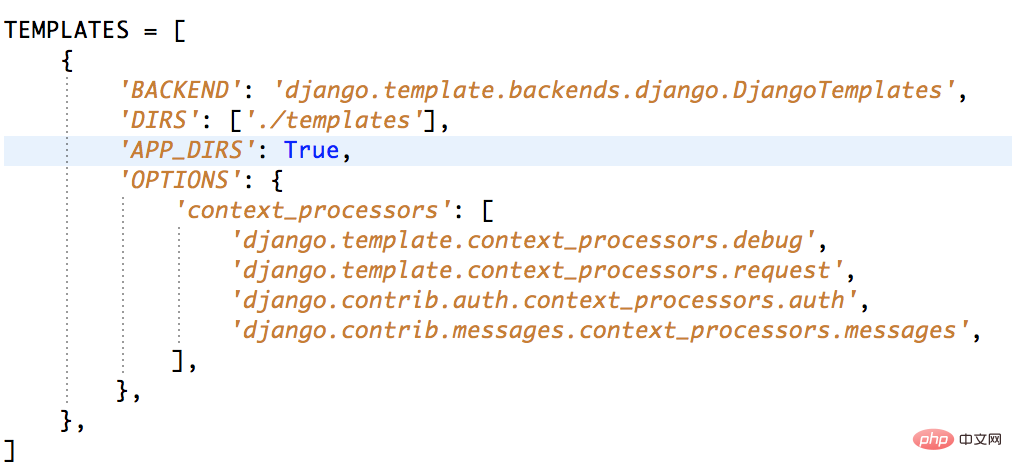
"It’s in DIRS" . Think about it, otherwise how would Django know that our html is placed here.
4-Logical layer (which is the last step, how to find out the things in the database and put them into HTML.)
4.1 Data in the database
Insert two pieces of data into the table
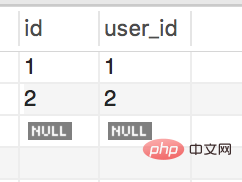
4.2 Dynamically display data
Look at the code: html part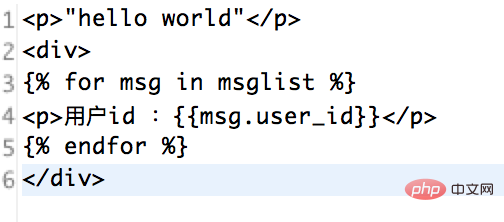

The above is the detailed content of Basic steps to build a website in python. For more information, please follow other related articles on the PHP Chinese website!

Hot AI Tools

Undresser.AI Undress
AI-powered app for creating realistic nude photos

AI Clothes Remover
Online AI tool for removing clothes from photos.

Undress AI Tool
Undress images for free

Clothoff.io
AI clothes remover

AI Hentai Generator
Generate AI Hentai for free.

Hot Article

Hot Tools

Notepad++7.3.1
Easy-to-use and free code editor

SublimeText3 Chinese version
Chinese version, very easy to use

Zend Studio 13.0.1
Powerful PHP integrated development environment

Dreamweaver CS6
Visual web development tools

SublimeText3 Mac version
God-level code editing software (SublimeText3)

Hot Topics
 1377
1377
 52
52
 Do mysql need to pay
Apr 08, 2025 pm 05:36 PM
Do mysql need to pay
Apr 08, 2025 pm 05:36 PM
MySQL has a free community version and a paid enterprise version. The community version can be used and modified for free, but the support is limited and is suitable for applications with low stability requirements and strong technical capabilities. The Enterprise Edition provides comprehensive commercial support for applications that require a stable, reliable, high-performance database and willing to pay for support. Factors considered when choosing a version include application criticality, budgeting, and technical skills. There is no perfect option, only the most suitable option, and you need to choose carefully according to the specific situation.
 How to use mysql after installation
Apr 08, 2025 am 11:48 AM
How to use mysql after installation
Apr 08, 2025 am 11:48 AM
The article introduces the operation of MySQL database. First, you need to install a MySQL client, such as MySQLWorkbench or command line client. 1. Use the mysql-uroot-p command to connect to the server and log in with the root account password; 2. Use CREATEDATABASE to create a database, and USE select a database; 3. Use CREATETABLE to create a table, define fields and data types; 4. Use INSERTINTO to insert data, query data, update data by UPDATE, and delete data by DELETE. Only by mastering these steps, learning to deal with common problems and optimizing database performance can you use MySQL efficiently.
 MySQL can't be installed after downloading
Apr 08, 2025 am 11:24 AM
MySQL can't be installed after downloading
Apr 08, 2025 am 11:24 AM
The main reasons for MySQL installation failure are: 1. Permission issues, you need to run as an administrator or use the sudo command; 2. Dependencies are missing, and you need to install relevant development packages; 3. Port conflicts, you need to close the program that occupies port 3306 or modify the configuration file; 4. The installation package is corrupt, you need to download and verify the integrity; 5. The environment variable is incorrectly configured, and the environment variables must be correctly configured according to the operating system. Solve these problems and carefully check each step to successfully install MySQL.
 MySQL download file is damaged and cannot be installed. Repair solution
Apr 08, 2025 am 11:21 AM
MySQL download file is damaged and cannot be installed. Repair solution
Apr 08, 2025 am 11:21 AM
MySQL download file is corrupt, what should I do? Alas, if you download MySQL, you can encounter file corruption. It’s really not easy these days! This article will talk about how to solve this problem so that everyone can avoid detours. After reading it, you can not only repair the damaged MySQL installation package, but also have a deeper understanding of the download and installation process to avoid getting stuck in the future. Let’s first talk about why downloading files is damaged. There are many reasons for this. Network problems are the culprit. Interruption in the download process and instability in the network may lead to file corruption. There is also the problem with the download source itself. The server file itself is broken, and of course it is also broken when you download it. In addition, excessive "passionate" scanning of some antivirus software may also cause file corruption. Diagnostic problem: Determine if the file is really corrupt
 Does mysql need the internet
Apr 08, 2025 pm 02:18 PM
Does mysql need the internet
Apr 08, 2025 pm 02:18 PM
MySQL can run without network connections for basic data storage and management. However, network connection is required for interaction with other systems, remote access, or using advanced features such as replication and clustering. Additionally, security measures (such as firewalls), performance optimization (choose the right network connection), and data backup are critical to connecting to the Internet.
 How to optimize database performance after mysql installation
Apr 08, 2025 am 11:36 AM
How to optimize database performance after mysql installation
Apr 08, 2025 am 11:36 AM
MySQL performance optimization needs to start from three aspects: installation configuration, indexing and query optimization, monitoring and tuning. 1. After installation, you need to adjust the my.cnf file according to the server configuration, such as the innodb_buffer_pool_size parameter, and close query_cache_size; 2. Create a suitable index to avoid excessive indexes, and optimize query statements, such as using the EXPLAIN command to analyze the execution plan; 3. Use MySQL's own monitoring tool (SHOWPROCESSLIST, SHOWSTATUS) to monitor the database health, and regularly back up and organize the database. Only by continuously optimizing these steps can the performance of MySQL database be improved.
 How to optimize MySQL performance for high-load applications?
Apr 08, 2025 pm 06:03 PM
How to optimize MySQL performance for high-load applications?
Apr 08, 2025 pm 06:03 PM
MySQL database performance optimization guide In resource-intensive applications, MySQL database plays a crucial role and is responsible for managing massive transactions. However, as the scale of application expands, database performance bottlenecks often become a constraint. This article will explore a series of effective MySQL performance optimization strategies to ensure that your application remains efficient and responsive under high loads. We will combine actual cases to explain in-depth key technologies such as indexing, query optimization, database design and caching. 1. Database architecture design and optimized database architecture is the cornerstone of MySQL performance optimization. Here are some core principles: Selecting the right data type and selecting the smallest data type that meets the needs can not only save storage space, but also improve data processing speed.
 Solutions to the service that cannot be started after MySQL installation
Apr 08, 2025 am 11:18 AM
Solutions to the service that cannot be started after MySQL installation
Apr 08, 2025 am 11:18 AM
MySQL refused to start? Don’t panic, let’s check it out! Many friends found that the service could not be started after installing MySQL, and they were so anxious! Don’t worry, this article will take you to deal with it calmly and find out the mastermind behind it! After reading it, you can not only solve this problem, but also improve your understanding of MySQL services and your ideas for troubleshooting problems, and become a more powerful database administrator! The MySQL service failed to start, and there are many reasons, ranging from simple configuration errors to complex system problems. Let’s start with the most common aspects. Basic knowledge: A brief description of the service startup process MySQL service startup. Simply put, the operating system loads MySQL-related files and then starts the MySQL daemon. This involves configuration




